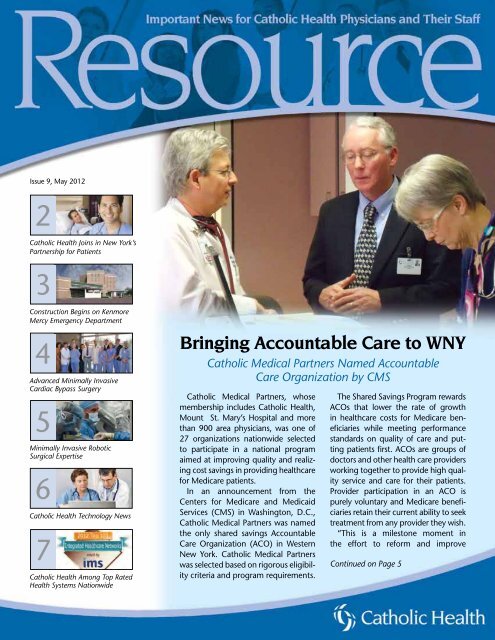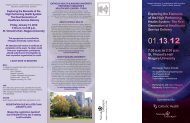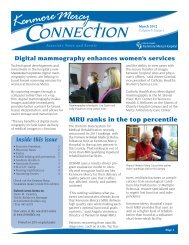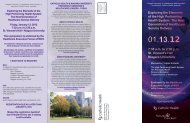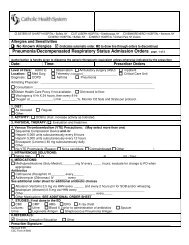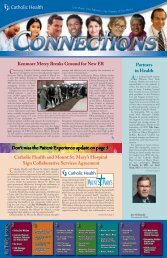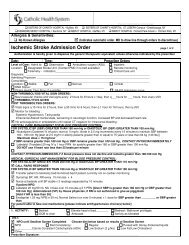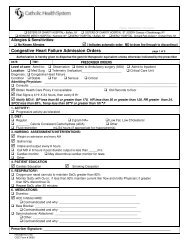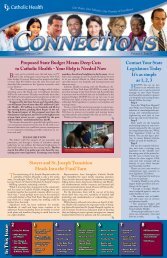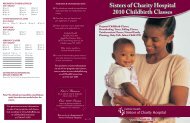to download a PDF of the - Catholic Health System
to download a PDF of the - Catholic Health System
to download a PDF of the - Catholic Health System
- No tags were found...
You also want an ePaper? Increase the reach of your titles
YUMPU automatically turns print PDFs into web optimized ePapers that Google loves.
Issue 9, May 20122<strong>Catholic</strong> <strong>Health</strong> Joins in New York’sPartnership for Patients3Construction Begins on KenmoreMercy Emergency Department4Advanced Minimally InvasiveCardiac Bypass Surgery5Minimally Invasive RoboticSurgical Expertise6<strong>Catholic</strong> <strong>Health</strong> Technology News7<strong>Catholic</strong> <strong>Health</strong> Among Top Rated<strong>Health</strong> <strong>System</strong>s NationwideBringing Accountable Care <strong>to</strong> WNY<strong>Catholic</strong> Medical Partners Named AccountableCare Organization by CMS<strong>Catholic</strong> Medical Partners, whosemembership includes <strong>Catholic</strong> <strong>Health</strong>,Mount St. Mary’s Hospital and morethan 900 area physicians, was one <strong>of</strong>27 organizations nationwide selected<strong>to</strong> participate in a national programaimed at improving quality and realizingcost savings in providing healthcarefor Medicare patients.In an announcement from <strong>the</strong>Centers for Medicare and MedicaidServices (CMS) in Washing<strong>to</strong>n, D.C.,<strong>Catholic</strong> Medical Partners was named<strong>the</strong> only shared savings AccountableCare Organization (ACO) in WesternNew York. <strong>Catholic</strong> Medical Partnerswas selected based on rigorous eligibilitycriteria and program requirements.The Shared Savings Program rewardsACOs that lower <strong>the</strong> rate <strong>of</strong> growthin healthcare costs for Medicare beneficiarieswhile meeting performancestandards on quality <strong>of</strong> care and puttingpatients first. ACOs are groups <strong>of</strong>doc<strong>to</strong>rs and o<strong>the</strong>r health care providersworking <strong>to</strong>ge<strong>the</strong>r <strong>to</strong> provide high qualityservice and care for <strong>the</strong>ir patients.Provider participation in an ACO ispurely voluntary and Medicare beneficiariesretain <strong>the</strong>ir current ability <strong>to</strong> seektreatment from any provider <strong>the</strong>y wish.“This is a miles<strong>to</strong>ne moment in<strong>the</strong> effort <strong>to</strong> reform and improveContinued on Page 5
May 20122<strong>Catholic</strong> <strong>Health</strong> Joins in New York’sPartnership for PatientsIn 2011, <strong>the</strong> Federal Governmentlaunched <strong>the</strong> Partnership for Patients:Better Care, Lower Costs, a newpublic-private partnership designed<strong>to</strong> help improve <strong>the</strong> quality, safety,and affordability <strong>of</strong> health care. ThePartnership for Patients brings <strong>to</strong>ge<strong>the</strong>rleaders <strong>of</strong> major hospitals,employers, physicians, nurses, and patientadvocates along with state andfederal governments in a shared effort<strong>to</strong> make hospital care safer, more reliable,and less costly.The two goals <strong>of</strong> this new partnershipare <strong>to</strong>:• Keep patients from gettinginjured or sicker. By <strong>the</strong> end<strong>of</strong> 2013, preventable hospitalacquiredconditions woulddecrease by 40% compared <strong>to</strong>2010. Achieving this goal wouldmean approximately 1.8 millionfewer injuries <strong>to</strong> patients withmore than 60,000 lives savedover three years.• Help patients heal without complication.By <strong>the</strong> end <strong>of</strong> 2013,preventable complications duringa transition from one care setting<strong>to</strong> ano<strong>the</strong>r would be decreasedso that all hospital readmissionswould be reduced by 20% compared<strong>to</strong> 2010. Achieving thisgoal would mean more than 1.6million patients would recoverfrom illness without suffering apreventable complication requiringre-hospitalization within 30days <strong>of</strong> discharge.As part <strong>of</strong> this national effort,<strong>Catholic</strong> <strong>Health</strong> has joined NewYork State Partnership for Patients(NYSPFP), a statewide initiative involvingmore than 170 hospitals inactivities aimed at reducing hospitalcomplications and preventable readmissions.“New York State Partnershipfor Patients is ano<strong>the</strong>r <strong>to</strong>ol <strong>to</strong> measureas well as bolster our quality improvementand patient safety efforts,” saidJoe McDonald, president & CEO <strong>of</strong><strong>Catholic</strong> <strong>Health</strong>. “We already havevery active Quality and Patient SafetyDepartments in each <strong>of</strong> our ministriesthat will support <strong>the</strong> work we are doingwith our state partners.”NYSPFP is a joint project <strong>of</strong> <strong>the</strong><strong>Health</strong>care Association <strong>of</strong> New YorkState and <strong>the</strong> Greater New YorkHospital Association. The partnershipwill provide participating hospitalswith technical assistance, trainingopportunities and educational programming<strong>to</strong> build on existing qualityimprovement programs.“These initiatives include measureswe are already focusing on in our hospitals<strong>to</strong> enhance safety and improveclinical outcomes for our patients,”said John Kane, vice president <strong>of</strong>Quality and Patient Safety for <strong>Catholic</strong><strong>Health</strong>. “The central message here isthat improving quality and safety is ateam effort that will involve hospitalstaff at all levels, including clinical, administrativeand support personnel.”To kick-<strong>of</strong>f its participation, <strong>Catholic</strong><strong>Health</strong> asked all hospital staff and physicianleaders <strong>to</strong> participate in a comprehensivesurvey on patient safetyculture. The results <strong>of</strong> <strong>the</strong> survey willhelp raise awareness about patientsafety among hospital staff, identifyareas <strong>of</strong> strength and opportunities forimprovement, and evaluate <strong>the</strong> success<strong>of</strong> initiative designed <strong>to</strong> improvecare, enhance safety, and reduce preventablereadmissions.
May 20124Advanced Minimally InvasiveCardiac Bypass Surgery at <strong>Catholic</strong> <strong>Health</strong>John Bell-Thomson, MD, is one <strong>of</strong> a few surgeons in <strong>the</strong> nation <strong>to</strong> perform <strong>the</strong> TECAB procedure. Centered in above pho<strong>to</strong>,Dr. Bell-Thomson reunites with his patient, Edward Zimmerman and his wife, Mary Ann. At left are: Julie LaManna,senior direc<strong>to</strong>r <strong>of</strong> Cardiac Services; Penny Tirpak; Deborah Hetrick; Mercy President & CEO C.J. Urlaub; at right:Kristin Nigro; Jason Jankowiak, VP, Cardiac Service Line; Rebecca Klacko, Judy Keicher, and Brian Butler.<strong>Catholic</strong> <strong>Health</strong>’s Heart Center atMercy Hospital <strong>of</strong> Buffalo is one <strong>of</strong> justa handful <strong>of</strong> cardiac centers nationallyperforming Totally EndoscopicCoronary Artery Bypass Surgery(TECAB). TECAB is an entirely endoscopicrobotic surgery used <strong>to</strong> treatcoronary heart disease. It is an advancedform <strong>of</strong> minimally invasivecoronary artery bypass surgery thatallows bypass surgery <strong>to</strong> be conductedwithout opening <strong>the</strong> chest. Thetechnique involves three or four smallholes through which two robotic armsand one camera are inserted.Dr. John Bell-Thomson, chair <strong>of</strong> <strong>the</strong>Cardiothoracic Surgery Department atMercy Hospital, is among just a smallnumber <strong>of</strong> surgeons in <strong>the</strong> United Statesperforming minimally invasive TECABsurgery using <strong>the</strong> da Vinci ® RoboticSurgical <strong>System</strong>. He has performedmore than ten TECAB procedures since<strong>the</strong> fall <strong>of</strong> 2011. On February 8, 2012,he successfully completed double coronaryartery bypass surgery for <strong>the</strong> firsttime using <strong>the</strong> TECAB procedure. Hispatient was able <strong>to</strong> return home from<strong>the</strong> hospital just two days later.“I am pleased <strong>to</strong> be able <strong>to</strong> <strong>of</strong>fermy patients this new medicalbreakthrough in heart surgery,” saidDr. Bell-Thomson. “High-precisionrobotic-assisted surgery is helping uspioneer a new standard for coronarybypass surgery with significant benefits<strong>to</strong> our patients, including fasterrecovery, less risk for complications,and less discomfort and scarring.”Following TECAB surgery, most patientsspend about one <strong>to</strong> three days in<strong>the</strong> hospital and can usually eat, drinkand walk around within hours after<strong>the</strong> procedure. Besides eliminating <strong>the</strong>need for a 6 <strong>to</strong> 10 inch incision down<strong>the</strong> chest, <strong>the</strong> TECAB procedure allowspatients <strong>to</strong> return <strong>to</strong> normal activitieswithin two <strong>to</strong> three weeks after <strong>the</strong> surgery.In comparison, a patient undergoingtraditional, open chest surgeryexperiences a 5 <strong>to</strong> 7 day hospital stayand a 4 <strong>to</strong> 8 week recovery time.<strong>Catholic</strong> <strong>Health</strong> Surgeons at bothMercy Hospital <strong>of</strong> Buffalo and Sisters<strong>of</strong> Charity Hospital utilize robotictechnology for a variety <strong>of</strong> minimallyinvasive surgical procedures, includingcardiac, general, gynecological andurological surgery.
May 20126<strong>Catholic</strong> <strong>Health</strong> Technology News<strong>Catholic</strong> <strong>Health</strong> Serves as Men<strong>to</strong>r For New HIT Program<strong>Catholic</strong> <strong>Health</strong> leads <strong>the</strong> regionin health information technology(HIT) and will soon help createstatewide opportunities for emergingtechnology firms thanks <strong>to</strong> anew program designed <strong>to</strong> accelerateHIT development in New York.Selected as one <strong>of</strong> only 18 “men<strong>to</strong>rs”in New York’s Digital <strong>Health</strong>Accelera<strong>to</strong>r (NYDHA) program,<strong>Catholic</strong> <strong>Health</strong> leaders and clinicianswill provide insight and guidance<strong>to</strong> cutting-edge technologyfirms and investment companieswho are partnering <strong>to</strong> develop better health informationtechnology and bring it <strong>to</strong> market more quickly.“Transforming healthcare in our community is going<strong>to</strong> depend on our ability <strong>to</strong> effectively leverage innovativetechnology,” said Joe McDonald, president & CEO <strong>of</strong><strong>Catholic</strong> <strong>Health</strong>. “This program will allow us <strong>to</strong> lend realworldexperience <strong>to</strong> those building <strong>the</strong> <strong>to</strong>ols we need andencourage high-tech investment inour community.”The program will make NewYork a hub for <strong>the</strong> emerging digitalhealth technology industry. By<strong>of</strong>fering participants <strong>the</strong> opportunity<strong>to</strong> engage directly with healthproviders including hospitals,long term care facilities, communityhealth centers, and primarycare practices, NYDHA will create<strong>the</strong> next generation <strong>of</strong> healthinformation technology, generatehundreds <strong>of</strong> new jobs, and attractmillions <strong>of</strong> dollars in new investment in New York State.“We are excited <strong>to</strong> serve as a men<strong>to</strong>r in <strong>the</strong> Digital <strong>Health</strong>Accelera<strong>to</strong>r program,” said Michael Galang, DO, senior vicepresident and CIO, <strong>Catholic</strong> <strong>Health</strong>. “By bringing <strong>to</strong>ge<strong>the</strong>rHIT developers, inves<strong>to</strong>rs and end users, this program canhelp bring <strong>to</strong> market technologies that are better suited <strong>to</strong>our needs, quickly and efficiently.”New Security Process for Physician Remote AccessRemote access <strong>to</strong> <strong>Catholic</strong> <strong>Health</strong> information systemsrequires a “two fac<strong>to</strong>r” au<strong>the</strong>ntication process for securitypurposes – that is, something you know (Username andPassword) and something you have (RSA Token – “Fob”).The fob displays a randomly generated number that is enteredalong with your username and password.The fob is a “perishable” device that eventually expiresand must be replaced; additionally it represents ano<strong>the</strong>rdevice that must be carried around by our medical staff.We are pleased, however, <strong>to</strong> now be able <strong>to</strong> <strong>of</strong>fer you anew way <strong>to</strong> au<strong>the</strong>nticate <strong>to</strong> <strong>the</strong> <strong>Catholic</strong> <strong>Health</strong> IT systemwithout using a fob.The new process relies on a numerical passcode that isgenerated by a technology called “Anakam” and is transmitted<strong>to</strong> your cell phone – thus, your phone replaces yourfob for <strong>the</strong> au<strong>the</strong>ntication process.The Anakam process is available only <strong>to</strong> physicians andmid-level providers – <strong>of</strong>fice staff who require remote accesswill still need <strong>to</strong> use a fob. You will be able <strong>to</strong> retain your fobuntil such time as you are comfortable using <strong>the</strong> Anakamprocess or until it expires. Once you become confident with<strong>the</strong> Anakam process, you can return your fob <strong>to</strong> a receptaclelocated in <strong>the</strong> <strong>Health</strong> Information Management (HIM)department or Medical Staff Office (MSO) at any <strong>Catholic</strong><strong>Health</strong> hospital. Please call Adam Lange, physician supportanalyst at 548-1622 with any questions.
7<strong>Catholic</strong> <strong>Health</strong> Among Top Rated<strong>Health</strong> <strong>System</strong>s in Nationwide Top 100For <strong>the</strong> fifth consecutive year,<strong>Catholic</strong> <strong>Health</strong>, Buffalo, NY, has beennamed <strong>to</strong> <strong>the</strong> nation’s list <strong>of</strong> mostintegrated healthcare networks, <strong>the</strong>“2012 IMS IHN (Integrated <strong>Health</strong>Network) 100,” (Formerly <strong>the</strong> SDI IHN100). <strong>Catholic</strong> <strong>Health</strong> ranked 42nd in<strong>the</strong> 2012 survey, with Geisinger <strong>Health</strong><strong>System</strong> in Danville, PA (2nd overall)and North Shore-LIJ <strong>Health</strong> <strong>System</strong> inGreat Neck, NY (31st overall) as <strong>the</strong>only higher ranked healthcare networksin <strong>the</strong> Nor<strong>the</strong>ast.The ranking recognizes <strong>the</strong> 100most integrated networks nationwide,graded annually on operations, quality,scope <strong>of</strong> services and efficiency. The surveywas conducted by SDI <strong>Health</strong> LLC,a nationally recognized healthcare dataand consulting firm based in PlymouthMeeting, PA. In Oc<strong>to</strong>ber 2011, SDI wasacquired by IMS <strong>Health</strong>care, a leadingprovider <strong>of</strong> information, services andtechnology for <strong>the</strong> healthcare industryaround <strong>the</strong> world.“Our continued strong performancein this survey underscores <strong>the</strong> progresswe have made in leading <strong>the</strong> transformation<strong>of</strong> healthcare in our region,”said Joe McDonald, president & CEO<strong>of</strong> <strong>Catholic</strong> <strong>Health</strong>. “Better integrationis <strong>the</strong> hallmark <strong>of</strong> a high performinghealthcare system.”<strong>Catholic</strong> <strong>Health</strong> first made <strong>the</strong> Top100 list in 2008 and achieved its highestranking in 2011 when it reached30th in <strong>the</strong> nation. No o<strong>the</strong>r healthcaresystem in Western New Yorkranks in <strong>the</strong> <strong>to</strong>p 50.The IMS IHN 100 survey programinvites hundreds <strong>of</strong> health systemsfrom across <strong>the</strong> nation <strong>to</strong> submit surveycase presentations in eight criticalareas including: integration, outpatientutilization, integrated technology,financial stability, services andaccess, contract capabilities, and physicians.<strong>Health</strong> systems are graded onperformance levels in each category,which are weighted in value, resultingin an overall score and placement in<strong>the</strong> ranking.Participation in <strong>the</strong> SDI 100 surveyis voluntary and no fees are charged<strong>to</strong> participating organizations. The fullreport on <strong>the</strong> 2012 IMS IHN Top 100was published in <strong>the</strong> January 23 edition<strong>of</strong> Modern <strong>Health</strong>care.www.modernhealthcare.comHeart Surgery Program ReceivesHighest Rating From STSThe Heart Center at Mercy Hospital <strong>of</strong>Buffalo, <strong>the</strong> surgical center <strong>of</strong> <strong>Catholic</strong><strong>Health</strong>’s Cardiovascular Services program,has been awarded a three-starnational quality rating by <strong>the</strong> Society <strong>of</strong>Thoracic Surgeons (STS) for <strong>the</strong> periodcovering July 1, 2010 <strong>to</strong> June 30, 2011.Approximately 14% <strong>of</strong> <strong>the</strong> 1,044 participatinghospitals across <strong>the</strong> countryreceived a “three-star” rating – <strong>the</strong>highest award under <strong>the</strong> STS qualityrating system – for heart bypass sur-gery, also called coronary artery bypassgraft surgery or CABG.“It is important <strong>to</strong> share quality data<strong>to</strong> tell <strong>the</strong> public how we are doing and<strong>to</strong> compare ourselves <strong>to</strong> o<strong>the</strong>r similarheart surgery programs on a nationalscale,” said Dr. John Bell-Thomson,chair <strong>of</strong> Mercy Hospital’s CardiothoracicSurgery Department.The Heart Center at Mercy Hospitalalso achieved a STS three-star nationalrating for <strong>the</strong> period covering January2010 <strong>to</strong> December 2010. As <strong>the</strong> nation’spremier pr<strong>of</strong>essional society forcardiothoracic surgeons, STS developeda comprehensive system thatallows patients <strong>to</strong> compare <strong>the</strong> quality<strong>of</strong> cardiac surgery among hospitalsnationwide using <strong>the</strong> largest singlespecialtydatabase in <strong>the</strong> country.


